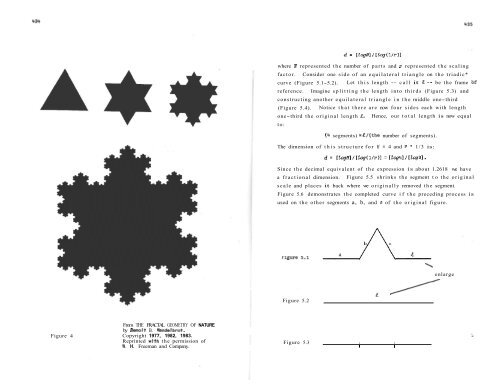Vol. 8 No 7 - Pi Mu Epsilon
Vol. 8 No 7 - Pi Mu Epsilon
Vol. 8 No 7 - Pi Mu Epsilon
Create successful ePaper yourself
Turn your PDF publications into a flip-book with our unique Google optimized e-Paper software.
where N represented the number of parts and r represented the scaling<br />
factor. Consider one side of an equilateral triangle on the triadic*<br />
curve (Figure 5.1-5.2).<br />
Let this length -- call it k -- be the frame of<br />
reference. Imagine splitting the length into thirds (Figure 5.3) and<br />
constructing another equilateral triangle in the middle one-third<br />
(Figure 5.4). <strong>No</strong>tice that there are now four sides each with length<br />
one-third the original length i. Hence, our total length is now equal<br />
to:<br />
(4 segments) xl/(the number of segments).<br />
The dimension of this structure for If = 4 and P = 1/3 is:<br />
Since the decimal equivalent of the expression is about 1.2618 we have<br />
a fractional dimension. Figure 5.5 shrinks the segment to the original<br />
scale and places it back where we originally removed the segment.<br />
Figure 5.6 demonstrates the completed curve if the preceding process is<br />
used on the other segments a, b, and e of the original figure.<br />
\<br />
enlarge<br />
Figure 5.2<br />
Figure 4<br />
From THE FRACTAL GEOMETRY OF NATURE<br />
by Benoit B. Mandelbrot.<br />
Copyright 1977, 1982, 1983.<br />
Reprinted with the permission of<br />
W. H. Freeman and Company.<br />
Figure 5.3 I I<br />
I<br />
I
















